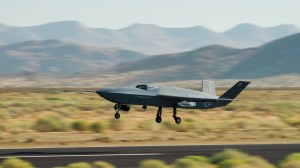Gen. Wilsbach sworn in as Air Force chief, pledges to advance modernization and readiness

In his first message to airmen as chief of staff of the Air Force, Gen. Kenneth Wilsbach vowed that the service’s multitude of modernization efforts will be among his top priorities.
“We must guarantee that tomorrow’s Airmen inherit an Air Force that can win,” Wilsbach wrote in a letter to the force. “We will advocate relentlessly for programs like the F-47, Collaborative Combat Aircraft as well as nuclear force recapitalization through the Sentinel program and the B-21.”
Senators confirmed Wilsbach as the 24th Air Force chief of staff on Oct. 30, promoting him to the service’s highest ranking military officer responsible for organizing, training and equipping the force. The Trump administration nominated Wilsbach for the position in September following the surprise announcement of Gen. David Allvin’s early retirement.
Wilsbach — who was officially sworn in Monday — enters the role at a significant time for the Air Force, as the service is grappling with a number of concurrent initiatives to sustain its current capabilities while also modernizing for potential future conflicts in the Indo-Pacific against high-tech adversaries. Ahead of his confirmation hearing, Wilsbach noted that the organization’s greatest challenge will be striking a balance between legacy fleet readiness and modernization with funding resources available.
“This imbalance risks hollowing the force and delaying transformation needed to meet pacing threats,” he wrote in his responses to advance policy questions from senators. “If confirmed, I would address this by making hard divestment decisions and advocating for stable funding to support modernization and readiness simultaneously.”
Along with prioritizing the service’s major modernization programs — from sixth-generation platforms like the F-47 fighter jet and B-21 Raider bomber to Collaborative Combat Aircraft (CCA) — Wilsbach also pledged to speed up acquisition of new capabilities.
“Just as important, we must shorten the time it takes to move from concept to combat power while empowering our innovators to move faster,” he wrote.
At the same time, the status of the current fleet will remain a top priority for Wilsbach during his tenure. While serving at the helm of Air Combat Command, Wilsbach often advocated for improved readiness and standards.
In his first letter as chief of staff, he stressed to airmen that at its core, the Air Force’s mission will continue to be flying and fixing its aircraft so the service is ready to fight when needed.
“Readiness is our first responsibility. Aircraft availability, aircrew proficiency, and the ability to generate combat power at scale are not just metrics, they are the measure of our credibility as a fighting force,” Wilsbach wrote. “We will restore and sustain full-spectrum readiness by balancing the demands of today’s operations with the modernization required for tomorrow’s fight.”






